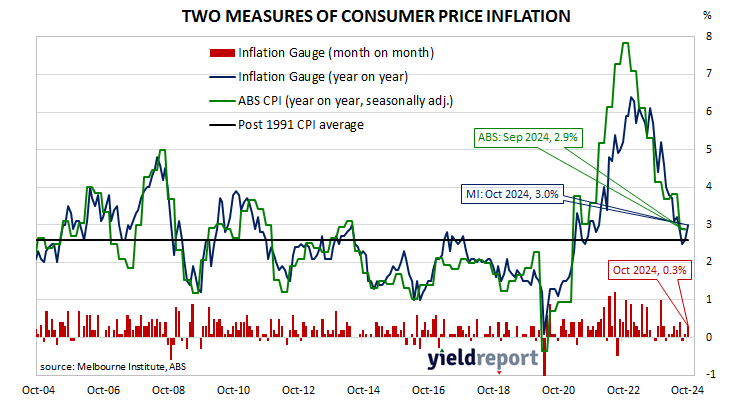Summary: Melbourne Institute Inflation Gauge index up 0.3% in October; up 3.0% on annual basis; Westpac: reflects unwinding of first instalment of electricity rebate; short-term ACGB yields steady, longer-terms yields rise; rate-cut expectations largely unchanged, February cut not especially likely.
The Melbourne Institute’s Inflation Gauge is an attempt to replicate the ABS consumer price index (CPI) on a monthly basis. It has turned out to be a reliable leading indicator of the CPI, although there are periods in which the Inflation Gauge and the CPI have diverged for as long as twelve months. On average, the Inflation Gauge’s annual rate tends to overestimate the ABS rate by around 0.1%, or at least until recently.
The Melbourne Institute’s latest reading of its Inflation Gauge index indicates consumer prices increased by 0.3% in October, up from 0.1% in September and in contrast with August’s 0.1%. Inflation on an annual basis accelerated from 2.6% to 3.0%.
“The acceleration in part reflects an unwind of the first instalment of the Federal Government’s electricity rebates,” said Westpac senior economist Pat Bustamante.
Short-term Australian Commonwealth Government bond yields finished steady on the day while longer-term yields increased modestly, lagging the upward movements of US Treasury yields on Friday night. By the close of business, the 3-year ACGB yield had returned to its starting point at 4.04%, the 10-year yield had added 2bps to 4.57% while the 20-year yield finished 1bp higher at 4.90%.
Expectations regarding rate cuts in the next twelve months remained largely unchanged, with a February 2025 rate cut not viewed as especially likely. Cash futures contracts implied an average of 4.33% in November, 4.305% in December and 4.26% in February 2025. September 2025 contracts implied 3.915%, 42bps less than the current cash rate.
Central bankers desire a certain level of inflation which is “sufficiently low that it does not materially distort economic decisions in the community” but high enough so it does not constrain “a central bank’s ability to combat recessions.”


